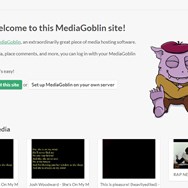About MediaGoblin
GNU MediaGoblin (GMG) offers a powerful and ethical approach to media hosting. Unlike proprietary, centralized platforms, GMG puts you in control. It's server software that you can run yourself, giving you ownership of your data and direct control over how your media is shared.
**Key aspects include:**
* **Decentralization:** GMG instances can connect and federate, creating a distributed network where users on different instances can interact and share media, independent of any single point of control.
* **Media Type Support:** GMG is designed to handle a wide variety of media formats, including images, videos, and audio, making it a versatile platform for diverse creative outputs.
* **Emphasis on Freedom:** Built on the principles of the GNU project, GMG is Free Software, meaning you have the freedom to run, study, distribute, and modify the software. This transparency and flexibility are core to its ethos.
* **User-Centric Design:** While technically a server software, GMG provides a user-friendly interface for uploading, organizing, and sharing media. Features like category filters and commenting systems enhance the user experience.
* **Customization:** The platform supports themes and customization, allowing instance administrators to tailor the look and feel of their MediaGoblin site.
Expert Review
GNU MediaGoblin: A Decentralized Haven for Digital Media
GNU MediaGoblin emerges as a compelling alternative in a digital landscape increasingly dominated by centralized media platforms. At its core, MediaGoblin is a free and open-source server software designed for hosting and sharing various forms of digital media. It’s not a service you sign up for; rather, it’s a platform you can run yourself (or join an instance hosted by someone else), fundamentally shifting the power dynamic from platform provider to the user or instance administrator.
One of the most significant aspects of MediaGoblin is its commitment to decentralization. The software supports federation, allowing different MediaGoblin instances to connect and interact with each other. This creates a distributed network where users on one instance can follow users on another, comment on their media, and share content across the network without relying on a single entity. This architecture is crucial for resisting censorship and ensuring data longevity.
The range of media types supported is a key strength. While many platforms specialize in one or two forms, MediaGoblin aims to be a versatile hub for images, videos, and audio. This means you can potentially consolidate your photo albums, video library, and music collection onto a single self-hosted platform. Features like category filters and photo organization tools aid in managing diverse media collections.
From a technical standpoint, MediaGoblin aligns with the GNU project's philosophy, being entirely Free Software. This means the source code is open for anyone to inspect, modify, and distribute. This transparency is invaluable for security and allows for community-driven development and customization. The platform is designed to run on GNU/Linux-libre systems, reinforcing its commitment to software freedom.
For users, the experience of browsing and interacting with media on a MediaGoblin instance is generally straightforward. The interface is functional, allowing for commenting, sharing, and viewing media. The availability of themes allows instance administrators to customize the look and feel, providing some level of personalization. The built-in commenting system fosters community interaction around shared media.
However, deploying and managing a MediaGoblin instance requires some technical proficiency. It's server software, so users interested in self-hosting need access to a server or hosting environment and the ability to configure and maintain it. While the documentation is available, it presents a higher barrier to entry compared to simply signing up for a centralized service. Users who are not comfortable with server administration may need to rely on finding and joining an existing public MediaGoblin instance.
Scalability can also be a consideration for instance administrators. As the amount of media and the number of users on an instance grow, so do the resource requirements (storage, bandwidth, processing power). Optimizing performance and ensuring smooth media streaming, particularly for high-resolution video, requires careful planning and potentially more powerful hardware.
Despite the technical requirements for administrators, the end-user experience on a well-maintained instance is generally positive. The absence of advertising is a significant plus, contributing to a cleaner and more privacy-respecting browsing environment. The ability to embed media elsewhere is also a useful feature for sharing content on blogs or other websites.
In conclusion, GNU MediaGoblin is a valuable project that provides a robust and ethically sound alternative to centralized media hosting. Its decentralized nature, support for varied media types, and adherence to Free Software principles make it a powerful tool for those who prioritize control, privacy, and freedom in their online media sharing. While setting up and running an instance requires technical skill, the benefits of data ownership and participation in a decentralized network make it a compelling choice for individuals and communities looking for a different way to share digital media.







